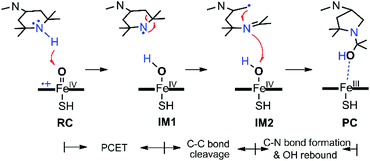Fu, Z.; Yang, L.; Sun, D.; Qu, Z.; Zhao, Y.; Gao, J.; Wang, Y.. Dalton Transactions, 2020, 49, 11099-11107
Ring contraction of piperidine drugs by cytochrome P450 enzymes (P450s) is among the most important drug metabolisms for human beings. However, the underlying mechanism remains elusive and controversial even after decades of experimental study. Kohn–Sham density functional theory (KS-DFT) combined with multistate density functional theory (MSDFT) was used to explore the chemical nature of ring contraction of 2,2′,6,6′-tetramethylpiperidine (2,2′,6,6′-TMPi) mediated by the active species, Compound I of P450s. Our calculated results demonstrate that ring contraction is initiated by N–H bond activation. MSDFT combined with KS-DFT methods revealed that the N–H bond activation involves an initial tightly coupled electron–proton pair, essentially of hydrogen atom transfer (HAT) character prior to the diabatic crossing point, after which the mechanism is dominated by the concerted electron proton transfer (CEPT) product formation. The nascent N-centered radical intermediate undergoes electron tautomerism via rate-limiting homolytic C–C bond cleavage (ca. 21 kcal mol−1) to form a ring-opened, carbon-centered radical imine intermediate. The following barrierless C–N bond formation concomitant with hydroxyl rebound from the Fe–OH moiety forms the ring-contracted pyrrolidine product. To the best of our knowledge, this is the first application of MSDFT in P450 chemistry, and also the first comprehensive theoretical report on the ring contraction mediated by P450, in which the revealed new mechanism will undoubtedly promote relative rational drug design.

